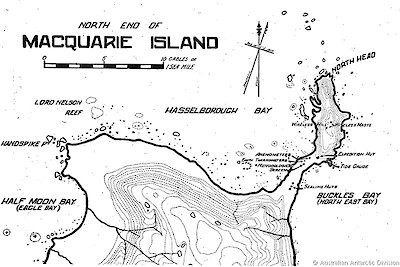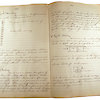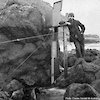Restless seas
Measuring the sea’s tidal rises and falls was also to be the task of Ainsworth, but he was handicapped from the start by a failure to land the instruments for the gauge during Aurora’s first visit in December 1911. These arrived in June 1912, during the ship’s midwinter cruise.
During the easterly weather that persisted during Aurora’s December 1911 visit, the heavy tide gauge pipe had been landed on the western shore below Wireless Hill at Aerial Cove. It looked sheltered then, but six months of prevailing westerlies persuaded Ainsworth that a more suitable site was the relatively sheltered Garden Cove, close to the Shack on the eastern shore.
The landed pipe was too heavy to carry, so improvisation was called for. ‘Two snow-gauges, eight inches each in diameter, were amongst the meteorological equipment and it appeared that if these two were soldered together a suitable pipe could be made,’ wrote Ainsworth. Sandell soldered the two together. The supplied float was too wide for the new pipe, so Sandell also made a smaller one.
Then the real work started. As Ainsworth recorded, Sandell and I worked for five days to assemble and place the instrument. ‘We could work on it only at low tide, for much rock had to be chipped away and numerous wire stays fixed. The work was therefore of a disagreeable character.’
The gauge may have looked unprofessional — Ainsworth noted that its finished appearance ‘did not by any means suggest the amount of trouble we experienced in setting it up’ — but it functioned satisfactorily for 18 months from 1 July 1912. Heavy seas eventually washed it away late in 1913, but Ainsworth had been able to secure enough records for an effective tidal analysis.



